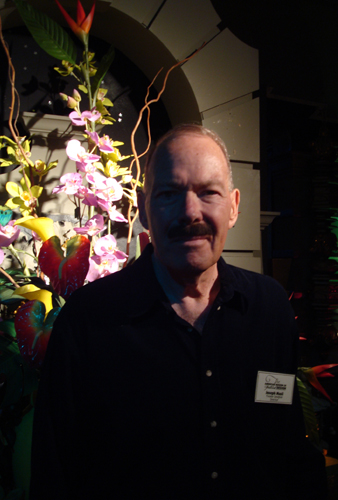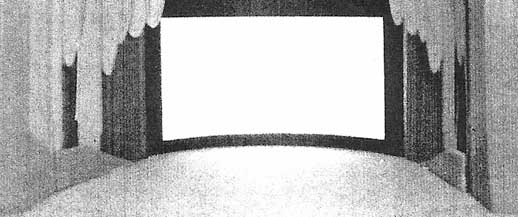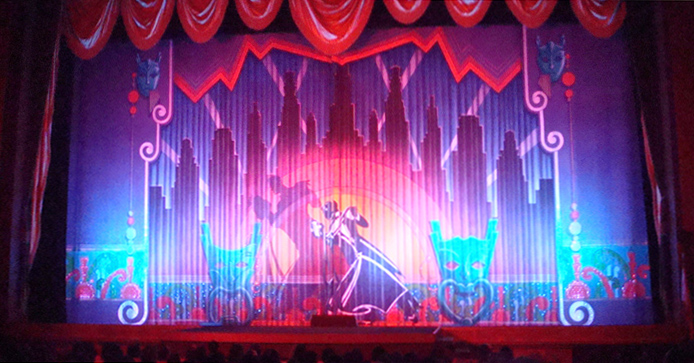JOSEPH MUSIL'S AMERICAN MUSEUM OF THEATRICAL DESIGN
Remembering a world-class theatre designer, and impeccable showman.
in Santa Ana's handsome Artists Village, tucked into a cozy corner on the top floor of the Santora Arts Building, was a haven for anyone interested in Classic Theatre Design...
Like the best theatres, here the show began out front.
The left window showcased historic memorabilia of the Fox Theatre in San Francisco.
The right window featured a model of one of Mr. Musil's most famous design projects, the El Capitan.

As you paid your admission, a dark figure emerged from the shadows. It was hard to imagine this modest visage contained the wild imagination that created what was inside... Joseph Musil's Salon of the Theatres!
One of the first things to meet your eye was this handsome rendering Mr. Musil created for a proposed acquisition and restoration of the Fox West Coast Theatre on Main Street at 3rd, in Santa Ana.
This stunning model was created by Musil in the style of the original Ziegfeld Theatre, home to live stage spectaculars, including the famous Ziegfeld Follies, which stood on New York's (6th) Avenue of the Americas between 54th and 55th street. The original Ziegfeld Theatre was replaced in the late 60s by an office building. The Ziegfeld name survives, however, on a handsome movie theatre behind that office building, on 54th street.
Many stylish theatres through the ages have been named the Rialto. Mr. Musil combined the style of several grand Rialtos in this model, accented by theatrical lighting, with several moving curtain and stage drops.
Early European Toy theatres were printed with fine intricate detail on heavy cardboard and assembled by hand. This real toy theatre from Germany was created in the early 20s...
...but the theatre's charm and full dimensions came to life with Mr Musil's theatrical lighting.
Mr. Musil created this Italian Opera House model for a proposed attraction at a Tokyo Disney theme park. It was during this time that he was approached by Disney executive Dick Cook with a plan... to transform a plain Westwood theatre...
...into a classic movie palace...
With a marquee that can capture your attention from blocks away.
Pacific Theatres owned the Crest, and though Pacific paid for the architect's plans, the actual makeover of the Theatre was paid for by the Disney studio, in exchange for the right to exclusively program their own pictures. Obviously the project was a success. In fact, it was by virtue of Mr. Musil's fantastic artistic embellishments that the Crest would eventually be named an historic landmark. Pacific eventually sold the theatre to an independent operator, who renamed it The Majestic Crest.
Mr. Musil recalled that Mr. Cook, who had not yet risen to his eventual high rank at the Disney Company, was making an admirably brave move in pushing for the studio to take on a theatre project. The Crest makeover was, Mr. Musil said, something of a test case, for if they were able to succeed with that, they would be in a better position to do what Mr. Cook really wanted to do...
Cook's idea was to turn Pacific's old Paramount Theatre on Hollywood Boulevard into a grand showplace, reminiscent of a theatre that he had fond memories of attending in his youth. That theatre also happened to have an old-fashioned ice cream parlor and candy store nearby.
Original plans for the studio-financed makeover of the Paramount honored Pacific's desire to divide the theatre into two. This rendering was Mr. Musil's design for the proposed upstairs (converted balcony) theatre.
This model was Mr. Musil's design for the downstairs theatre. (Note the resemblance to the interior of today's Majestic Crest) As much as Pacific Theatres wanted a commercial two screen cinema, the Disney Studio (most likely Mr. Cook) was looking for a large capacity theatrical venue with a fully functioning stage, to accommodate live shows along with a movie. (Many would come to recognize this as an attempt to create a showplace in the tradition of New York's Radio City Music Hall)
Because the Crest project was more or less under the radar at the time, Mr. Musil had been able to make over the theatre with a relatively free reign. He referred to the Crest as an example of what he could accomplish creatively without any corporate (studio executive) input. He later recalled the challenge he faced in getting his creative ideas accomplished in the El Capitan project, which drew much more scrutiny from the studio.
To misdirect executive attention away from many other creative things he wanted to do around the theatre, Mr. Musil designed an ornamental water fountain into a lobby space that was obviously too small for it. While arguing for the fountain, he managed to slip in a lot of other details, until he could finally "give up" on the fountain as an apparent compromise with the suits. A Disney executive later remembered Mr. Musil arguing for that fountain. He grinned and pointed to a mural on a wall of the theatre. That, he said, is where Mr. Musil finally got to have his fountain. But that, he may not have known, is probably where Mr. Musil intended the fountain to be all along. On the wall, not in the lobby. I'm sure those studio executives now would be pleased with all the other details Mr. Musil was able to bring into the project because of his clever diversion.
The El Capitan's glamorous marquee bears no resemblance whatsoever to the much plainer original. It is entirely a Joe Musil creation. Through the years, when he happened to see the marquee on television, Mr. Musil was very pleased to realize that his work has become "part of the fabric of Hollywood."
Speaking of fabric, Mr. Musil also knew just the right kind of fabric to choose for the gold contour curtain on the El Capitan's stage. Since the curtain would spend a lot of time pulled up, the wrong kind of fabric would crinkle permanently along the cable lines, making it obvious before it opened that the curtain drew up in swags from the bottom. This is the kind of expert detail he brought to any project. And when deviations have been made from his details, the results are clearly inferior.
In the same deal with Pacific that they had with the Crest, Disney paid for the El Capitan makeover. Eventually Disney took over operation of the theatre from Pacific, and when it came up for sale, the studio quietly bought the entire building. Today the El Capitan is a magnificent showplace that Disney is rightly proud of, all due in no small part to the talent of Joseph Musil.
Mr. Musil was also briefly consulted by Pacific Theatres for a makeover of the Cinerama Dome.

A rare photo of his model reveals just a little of the detail. Musil's very theatrical concept followed Cinerama's tradition of a single color for the theatre and the seats, which he called "Cinerama Salmon." He proposed a contour curtain, that would rise to reveal a signature traveler curtain with the Cinerama logo on it, a light show projected onto the Dome's ceiling, and even weaving the Cinerama logo into the carpeting. In conversations about that period, he revealed that the concept was to identify the new complex behind the Dome with the popular Cinerama name, having all the screens curved (but to a gentler degree), with a overall name like Cinerama Center. Pacific however, decided to reject Mr. Musil's infinitely more interesting concept, and went instead with a less distinctive name and the dim, dark, funereal navy blue look the Dome has now.
A candid conversation revealed Mr. Musil's feelings about the makeover of another Hollywood Boulevard theatre, where a decision was made to pointedly avoid the kind of work he had done for the El Capitan. The "design" company that was chosen had none of Mr. Musil's theatrical skill. He remarked that this firm derided and ridiculed his design work as "old fashioned." They proceeded to turn the other theatre into a black metal cage that doesn't draw a fraction of the El Capitan's patronage. Mr. Musil was certain that, with the budget spent on that project, he could have turned out a much more memorable result, and still pleased the preservationists.
Mr. Musil's theatre often presented a show that might consist of live acts, vintage movies, etc.
Here the show was emceed by former stage manager Simon Overton.
A theatre designer who understands showmanship is rare, but Mr. Musil was also a showman himself. He created the very theatrical curtain/light prologues that originally began the shows at the Majestic Crest and El Capitan theatres. The Crest had two curtains, The El Capitan was designed with three. All were programmed by Musil and timed to specially chosen music. Joseph Musil's own Strand Theatre had more curtains than most of us can count.
A regular feature at Mr. Musil's Strand Theatre was his signature "Cavalcade of Curtains."
Occasionally there were movie presentations, like this one on another vintage theatre.
Not long after we put up our page on the Vista Theatre in Hollywood, the owner of that theatre contacted us, asking how to contact Mr. Musil. That company, now called Vintage Cinemas, engaged Mr. Musil to give his theatrical touch to their planned makeover of the long-shuttered Village Theatre in Coronado, near San Diego. So Joseph Musil's fans then had one more theatre project to look forward to...

Joseph Musil, world class theatre designer, and hero to all who love classic theatrical showmanship, passed away at age 74 on June 29th, 2010. While the loss of his personality and creativity will be keenly felt, wonderful evidence of it remains to thrill audiences in theatres throughout the world. The next time you see the curtains open at the El Capitan, or the flickering marquee of the Majestic Crest, remember the creative genius whose idea it all was.
"I was so sad to hear of Joe's passing. Our 2005 Conclave visit to his Santa Ana studio will stay etched on my memory for all time. Such a gracious, elegant man. Such breathtaking art in his displays and models. He truly loved the showmanship and majesty of the golden days of theater. And those great days lived in his Salon. He will be greatly missed but never forgotten."
- Karen Colizzi Noonan, President, Theatre Historical Society of America
"I met Joe four times over the years, but perhaps the most memorable was the first time, in 1996... I was enchanted, and Joe was so thrilled to have a THS member come by for a visit... to "talk theatres" in his Salon. Especially memorable were his descriptions of the theatres of downtown Long Beach, which when I was a child, held a great fascination for me, as they beckoned mysteriously with forlorn facades...but my parents would never take me to any of them.
Another special memory is when he talked to us in the El Capitan during the '98 Conclave. He recounted how he had designed some display boards for the ticket lobby, advertising the live Disney stage show to be presented with the current movie. At the top of the display were the words, "ON OUR STAGE!" Right after this display was in place, Joe saw a couple of elderly gentlemen come up to the display, and one of them said, "Look! It says 'On Our Stage!', that's they way they used to do it!" Joe then echoed to us reflectively, "Yes. 'That's the way they used to do it." As he spoke, I heard his voice catch in his throat just a bit. My eyes fogged up. I may not have lived that era myself, but I completely understand the passion for it.
Joe kept the flame burning a little longer for the art of fantasy and True Showmanship, and we're all the better for that."
- Gary Parks, West Region Director, Theatre Historical Society
"I can only say I am grateful to have known him for the short time I did and very very lucky. Our goal now is to carry out his last design vision in Coronado."
- Lance Alspaugh, Vintage Cinemas
"I once received a Christmas card from Joe Musil. A miniature version of a vintage cardboard toy theatre, that he designed and drew up himself. I called and thanked him, mentioning, I think, that it reminded me of a toy theatre I had lost as a kid. A short time later, a nice package arrived, emblazoned with Joe's theatrical handwriting. Inside was a rather elegant, full-scale toy theatre, complete with curtain, scenery, etc., all designed by Joe himself, ready to be constructed. Typically thoughtful and classy. We had many talks about what the moviegoing experience could be, should be, and rarely was. Another creative giant, kindred spirit, and good man, lost far too soon."
- TJ Edwards, Cinema Sightlines
See and hear the man in his own words:
AN INTERVIEW WITH THEATRE DESIGNER JOSEPH MUSIL
Color photographs, curtain movie and text © 2007, 2008 by TJ Edwards

